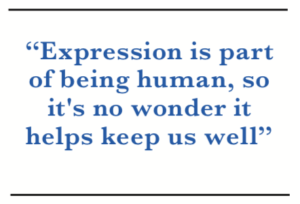
Communal art spaces “save people”
How Halifax’s open art studios address social justice and personal health
Whether it’s painting, writing music, or – if money’s tight – visual art with rice and soy sauce, Eric Diolola always meets his creative drive with creative action. He needs to.
“I grew up in a third world country, in the Philippines, so [art] is my passion because I can’t afford anything, to be honest,” he says, smiling. “I’m just creative with what materials I have at home.”
Diolola, 31, moved to Canada six years ago. He has depression, severe anxiety, ADHD and a history of epilepsy.
“All the good stuff,” he laughs. “It’s really hard for a mentally ill person, to finish the day somehow better. Finish the day so that you’re – not happy – but content,” he says.
“Art heals me.”
He sits at a table in the busy Wonder’neath Art Society studio, an independent art studio in North End Halifax, and dips a paintbrush into various shades of purple paint smeared on a paper plate. On the canvas in front of him is a purple blob, which is exactly what it’s supposed to be – a baby purple blob, actually.
“You can’t worry if you’re thinking about a cute blob to be put on a canvas,” he says.
Art as a social justice tool
Community groups and outreach programs that use art to address some of Halifax’s most prevalent social issues like mental health, racial tension, LGBTQ+ issues, and economic class have increased in number and proven popular. They don’t necessarily offer formal art therapy, but a similar version of support and exploration through art.
The American Art Therapy Association says common branches of art therapy include the advancement of societal and ecological change. Within the Halifax art scene, organizations like Wonder’neath, Dramatic Changes and The Blackbook Collective are affordable and accessible resources for people to get involved in art while connecting with the community and addressing important topics.
“There’s an underground and a very physical art space community here,” says Director of Chebucto Art Therapy and Counselling Centre, Nick Zwaagstra.
Diolola works at Wonder’neath, located in Halifax’s Hydrostone district. He got the job because he was such an appreciative and enthusiastic attendee of their programming; he offered to volunteer and Wonder’neath offered him a job.
“Eric is magic,” says Melissa Marr, co-founder and co-executive director of the society.
Wonder’neath aims to cultivate “a neighbourhood deeply connected through the arts.”
The organizers curate their programs based on what they feel the public wants or needs. They feel it out by being active members of their community and paying attention to feedback.
Marr says their interest is especially piqued by social justice issues.
One of their artists-in-residence, Bria Miller, often focuses on holding space for racialized and LGBTQ+ youth by hosting events like Show Yourself which took place in January 2018. She partnered with El Jones to provide a closed space for women of colour to engage in creative writing exercises focused on the suppression and silencing of their voices.
“It’s relevant because there are people of colour in Halifax,” says Shaya Ishaq about social justice art and community outreach.
Ishaq is a local artist and facilitator at Wonder’neath who partnered with the Khyber Centre For the Arts in December to create Black Libraries Matter: Collective Calls to Liberation. For this exhibit, she filled a space with books by inspirational Black authors and created her “dream space” with the help of other Black, Indigenous and artists of colour in the city.
She cited Halifax’s complicated and cruel history with Black Nova Scotians and Mi’kmaq people as reasons why work like her own carries particular significance here.
“It’s a way for us to contextualize these things,” she says.
Open studio, open minds
One of Wonder’neath’s most popular programs is the Open Studio program that’s been running since December 2014.
On any given Friday or Saturday from 2 p.m. to 7 p.m., one may open the door at the top of spiralled stairs in the nondescript, squarish building that houses Wonder’neath and be met with layers of laughter, the soft hammering sound of a sewing machine and the slathering of paint. One large room is home to countless art media and endless opportunity for anyone to make anything. The studio fills with people of all ages and often reaches capacity.
“We’ve heard that just having this communal space for art-making gets people out of their homes, maybe out of places that are hard,” says Marr. Especially during the holidays, a time that can be difficult and isolating for some people, Wonder’neath is somewhere to go to find good vibes and an inclusive community.
The Open Studio program is possible because of The 4Cs Foundation, a Halifax based organization that provides grants and supports community projects that align with their mandate: “to build creative connections between children and their communities through community arts projects.”
Marr sees the Open Studio program as an opportunity for people to come together across differences with the common interest of creativity. She says there is a lot of reasons Halifax doesn’t naturally come together, from generational differences to tense racial dynamics, but people of every demographic use the society’s studio—and for different reasons.
Creating a new space
Halifax will be getting a new art hub, expected to be ready in 2020. The province made a combined announcement with the federal government on Dec. 10 that funding had been approved for the Link Performing Arts Centre.
The Link will replace the World Trade Convention Centre and allow for artists of all kinds to rent space to pursue their artistic endeavours. Art ensembles will be able to rent space for short-term or long-term lease.
Halifax Pride, Youth Arts Connection and Pop Explosion are some of the few that have already expressed interest in using the space.
This new space will hopefully help bridge that gap of coming together that Marr says doesn’t happen naturally, and will allow for another communal space to escape the confines and isolation of doing art at home by yourself.
The Culture Link Community Interest Company incorporated in 2017 to help make this development possible.
Their website boasts, “we are dedicated to transforming the interaction of art and commerce by building inclusive facilities where work, play and collaboration combine.”
Informal healing process
Art isn’t just a communal activity but can be a personal healing activity for those who use it as an escape or an outlet. Coming together to heal can work in many different ways.
Marr says Wonder’neath’s programming is also an alternative to dealing with issues through formal and daunting bureaucratic processes. Folks can gain new perspective by connecting with others from varying backgrounds and feel support in a unique way.
“It’s grassroots and it’s different than lobbying for policy change, but it is a beginning in offering genuine support,” says Marr.
Using art to foster a healthy, low-stress environment isn’t a new concept. Halifax artists and art organizations are tapping into a cultural custom that’s been around for centuries.
Margaret Robinson, a bisexual and two-spirit member of the Lennox Island First Nation and assistant professor in the Department of Sociology and Social Anthropology at Dalhousie University, says she thinks her ancestors got it right when they put so much value on artistry. Mi’kmaq culture traditionally includes artwork like basketry, pottery, embroidery, quillwork, beading and petroglyphs.
“It works. It keeps people well. They were really onto something and we’re only now catching up and exploring why it works,” she said in an email.
For Robinson, the low cost of art-making is another reason we should invest more in art as a society.
“Expression is part of being human, so it’s no wonder it helps keep us well, even when we’re under enormous social pressures or are living with serious health issues,” she says. “I like to think it’s part of what’s helped Indigenous people survive.”
Diolola says part of the value of art for him is in the “magic” that happens when someone is inspired to create art, takes action, and makes it into something tangible.
“I think art still saves people,” says Diolola.







